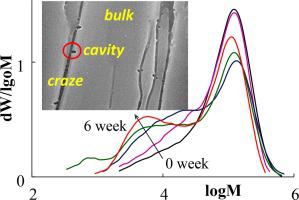当前位置:
X-MOL 学术
›
Eur. Polym. J.
›
论文详情
Our official English website, www.x-mol.net, welcomes your feedback! (Note: you will need to create a separate account there.)
Hydrolytic degradation of polylactide films deformed by the environmental crazing mechanism
European Polymer Journal ( IF 6 ) Pub Date : 2020-10-01 , DOI: 10.1016/j.eurpolymj.2020.110000 Elena S. Trofimchuk , Marina A. Moskvina , Nina I. Nikonorova , Alexander V. Efimov , Elizaveta S. Garina , Tatiana E. Grokhovskaya , Olga A. Ivanova , Artem V. Bakirov , Nikita G. Sedush , Sergei N. Chvalun
European Polymer Journal ( IF 6 ) Pub Date : 2020-10-01 , DOI: 10.1016/j.eurpolymj.2020.110000 Elena S. Trofimchuk , Marina A. Moskvina , Nina I. Nikonorova , Alexander V. Efimov , Elizaveta S. Garina , Tatiana E. Grokhovskaya , Olga A. Ivanova , Artem V. Bakirov , Nikita G. Sedush , Sergei N. Chvalun

|
Abstract Hydrolytic degradation of porous polylactide (PLA) films with various porosity and morphology has been thoroughly investigated. It has been found that the structural and mechanical modification of PLA films by the environmental crazing mechanism results in the formation of a porous structure, is accompanied by the change in molecular-weight characteristics of the polymer and affects the localization and rate of its hydrolytic degradation. After the films were exposed in phosphate-buffered saline solution at 37 °C for 6 weeks, their average molecular weights MW and MN decreased by 1.5–2 and 3–5 times respectively, while their dispersity ĐM increased to 4–5. For PLA films containing alternating porous crazes and nonporous bulk parts, the hydrolysis leads to the appearance of bimodal molecular-weight distribution (MWD) curves. The degradation of the polymer material localizes predominantly at the craze–bulk polymer interfaces, thereby leading to a rather rapid and significant decrease in the deformation and strength properties of the films, which eventually become brittle. For PLA films, that have completely passed to the fibrillar-porous structure during the hydrolytic degradation, the character of the MWD curves remains preserved, but they gradually widen and shift toward lower molecular weights. The destruction of similar samples occurs uniformly throughout the volume, and the changes in their structural and mechanical parameters are not so abrupt, and even after the hydrolysis for 6 weeks their strength remains at a level of 90 MPa. When the porous matrix of PLA is filled with calcium phosphate (up to 30 wt%), the degradation of the polymer material occurs predominantly in the crazes and hardly proceeds in the bulk parts. The approaches proposed using PLA as an example enable one to control the degradation processes in polymers by varying their structural and morphological characteristics and incorporating inorganic fillers, thus opening new ways to the creation of bioactive and biodegradable materials with predictable degradation times.
中文翻译:

由环境开裂机制变形的聚乳酸薄膜的水解降解
摘要 对具有各种孔隙率和形态的多孔聚乳酸 (PLA) 薄膜的水解降解进行了深入研究。已经发现,环境开裂机制对 PLA 薄膜的结构和机械改性导致多孔结构的形成,伴随着聚合物分子量特性的变化,并影响其水解降解的定位和速率. 薄膜在 37°C 的磷酸盐缓冲盐水溶液中暴露 6 周后,其平均分子量 MW 和 MN 分别降低了 1.5-2 倍和 3-5 倍,而分散度 ĐM 增加到 4-5。对于含有交替多孔裂纹和无孔散装部分的 PLA 薄膜,水解导致双峰分子量分布 (MWD) 曲线的出现。聚合物材料的降解主要集中在开裂-本体聚合物界面,从而导致薄膜的变形和强度性能迅速显着下降,最终变脆。对于在水解降解过程中完全进入纤维状多孔结构的 PLA 薄膜,MWD 曲线的特征保持不变,但它们逐渐变宽并向低分子量移动。类似样品的破坏在整个体积内均匀发生,其结构和力学参数的变化并不那么突然,即使水解6周后,其强度仍保持在90 MPa的水平。当 PLA 的多孔基体填充磷酸钙(高达 30 wt%)时,聚合物材料的降解主要发生在裂纹中,而在大块部分几乎不发生。以 PLA 为例提出的方法使人们能够通过改变聚合物的结构和形态特征并加入无机填料来控制聚合物的降解过程,从而为创造具有可预测降解时间的生物活性和可生物降解材料开辟了新途径。
更新日期:2020-10-01
中文翻译:

由环境开裂机制变形的聚乳酸薄膜的水解降解
摘要 对具有各种孔隙率和形态的多孔聚乳酸 (PLA) 薄膜的水解降解进行了深入研究。已经发现,环境开裂机制对 PLA 薄膜的结构和机械改性导致多孔结构的形成,伴随着聚合物分子量特性的变化,并影响其水解降解的定位和速率. 薄膜在 37°C 的磷酸盐缓冲盐水溶液中暴露 6 周后,其平均分子量 MW 和 MN 分别降低了 1.5-2 倍和 3-5 倍,而分散度 ĐM 增加到 4-5。对于含有交替多孔裂纹和无孔散装部分的 PLA 薄膜,水解导致双峰分子量分布 (MWD) 曲线的出现。聚合物材料的降解主要集中在开裂-本体聚合物界面,从而导致薄膜的变形和强度性能迅速显着下降,最终变脆。对于在水解降解过程中完全进入纤维状多孔结构的 PLA 薄膜,MWD 曲线的特征保持不变,但它们逐渐变宽并向低分子量移动。类似样品的破坏在整个体积内均匀发生,其结构和力学参数的变化并不那么突然,即使水解6周后,其强度仍保持在90 MPa的水平。当 PLA 的多孔基体填充磷酸钙(高达 30 wt%)时,聚合物材料的降解主要发生在裂纹中,而在大块部分几乎不发生。以 PLA 为例提出的方法使人们能够通过改变聚合物的结构和形态特征并加入无机填料来控制聚合物的降解过程,从而为创造具有可预测降解时间的生物活性和可生物降解材料开辟了新途径。



























 京公网安备 11010802027423号
京公网安备 11010802027423号